Stan’s been in a slump. He’s made very few winning trades in the past month. He’s starting to question his skills as a trader and wondering if he will ever return to profitability. He has taken it hard. Usually, Stan is energetic and ready to face the trading day with enthusiasm and vigour. But recently, he has approached the start of the trading day with dread and skepticism. Stan usually gets up early, changes into a comfortable pair of jeans and a golf shirt, and goes to his favorite diner for a light breakfast.
But these days, he stays in his bathrobe and doesn’t bother going out. He reasons, I might as well save the money on food and dry cleaning and just stay home. I’ll need the extra cash to recover from this drawdown. There’s a problem with Stan taking the drawdown so hard: He’s just making matters worse. Slumps and drawdowns are a fact of trading. One should expect them. But Stan is over-interpreting the significance of a drawdown. He’s letting it shake his confidence and he is changing his attitude and his behaviours to reflect a bleak, pessimistic outlook. However, it’s vital to stay optimistic in such times. Don’t make a drawdown even worse.
When events don’t go our way, we are especially vulnerable. Everyone has the potential to feel a little uneasy and question one’s skills and confidence when nothing seems to be going right. Suddenly, all the memories of our past glories may be forgotten and all our defeats brought to the forefront.
At that point, the availability heuristic may bias our outlook. When people make estimates of the probability of future events, they often use past memories as a basis for making these estimates. So if our past failures are at the forefront of our minds, we tend to predict poor outcomes for the future and have wavering confidence. On the other hand, if we only seem to remember our most brilliant successes, we tend to be overconfident. A little overconfidence when one is in a pit of despair may be more helpful than detrimental, however.
Stan has made the impact of the availability heuristic even worse. By changing his behaviours to be consistent with a pessimistic outlook, he has become even more discouraged. What he should have done was stay as consistent with his usual winning stance as possible. He should have done everything he usually did, such as changing into his work clothes and eating breakfast at his favourite diner as usual.
By sticking to his routine, he might have still felt a little uneasy and a little unsure of the future, but at least he would have not made the situation worse. In all likelihood, the slump would have passed and he would have soon returned to profitability. But in Stan’s case, his pessimistic view and his corresponding pessimistic behaviours created extreme feelings of despair, and when this happens to a trader, it may impact trading decisions, which may produce even more losses.
Trading is a challenging business. It’s essential that you maintain an objective, rational approach to trading. But there are times when slumps and drawdowns can shake the confidence of even the most astute trader. It’s at these times that one must be especially careful to avoid falling prey to pessimism and despair. It’s vital to keep a positive outlook, weather the storm, and persistently work to return to profitability.


